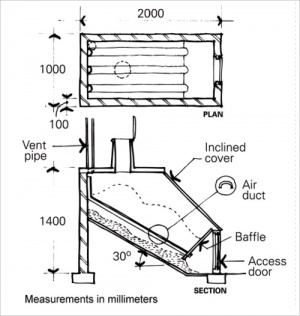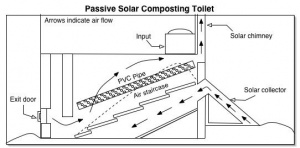Composting toilet




Composting toilets aerobically decompose waste material, by aerobic microorganisms in a highly aerated, warm (32°-49°) and moist (humidity >80%) environment, with ample carbon (sawdust as the sole agent will lead to clogging[5]). Optimally, the volume of the resulting compost may be about 10% of input.[6]
Continuous composting toilets are single container toilets that receive excrement which decomposes as it moves slowly through the container and is removed as compost from the end-product chamber. The container is permanently fitted under the toilet seat, and never has to be fully emptied as the compost can be gradually removed when it reaches the end-product chamber. [7] To make the fresh material move down the slope, the slope needs to be slippery, eg bathroom tiles.
In a non-unrine-diverting system, 90% of what goes into a composting toilet is water. Compost piles need to be damp to work well, but most composting toilets suffer from too much water. (ideally 45 to 70% moisture content [8]) Ammonia may evaporate as nitrogen in a gas form, which is vented out along with carbon dioxide and water vapor.[9] Evaporation is the primary way a composting toilet gets rid of excess water. Warmth and air flow through the unit assist the evaporation process. Every composting toilet has a vertical vent pipe to carry off moisture. Air flows across the drying trays, around and through the pile, then up the vent to the outside of the building. The low-grade heat produced by composting is supposed to provide sufficient updraft to carry vapor up the vent.[10]
Dry material, which contains carbon (such as dry leaves or grasses) increase composting properties. It regulates moisture and the carbon to nitrogen ratio (C/N) and enhances the composting process. If ash and lime are used as adding material, this has the additional beneficial effect of raising pH, which leads to improved pathogen die-off (JOENSSEN et al. 2004, see also SCHOENNING & STENSTROEM 2004 for more information on alkaline treatment). The carbon to nitrogen ration (C/N) of excreta (including urine) is about 7 to 8, but for optimal thermophilic composting, it needs to be 20 to 35 (WHO 2006). Excessive ammonia from urine inhibits the microbial processes in the chamber. With urine diversion, less bulking agent is needed and the C/N ratio is naturally enhanced.
If operation conditions for thermophilic composting are adequate (moisture content 50 to 60%, carbon to nitrogen ratio 30 to 35 and mixing with bulking material), the temperature will rise to between 50 and 65 °C (WHO 2006). Such temperatures will effectively inactivate pathogens (WHO 2006).[11] If moisture content is too high, anaerobic organisms will thrive, creating undesirable odors from anaerobic digestion.
Urine
Urine can contain up to 90 percent of the nitrogen, up to 50 percent of the phosphorus, and up to 70 percent of the potassium present in human excreta.[12] In healthy individuals it is usually pathogen free, although undiluted it may contain inorganic salts and organic compounds at levels toxic to plants.